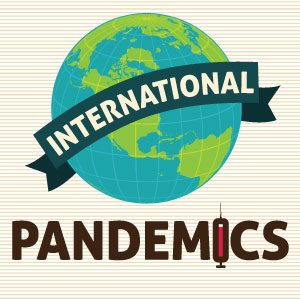The International Pancemics infographic takes a look at the history and present state of disease outbreaks around the world.
International Pandemics
Illness has been one of the most formative forces in the history of the human race. While a number of the world’s worst illnesses have been eradicated through medical advancements, many under the radar illnesses have the ability to spread like wildfire (and some currently don’t have cures). Let’s take a look at the history and present state of international pandemics.
Featured Programs
Pandemic–
Pan= “all”
Epidemic= Widespread occurrence of infectious disease.
What to look for
One: No animal virus that can cause infection in humans was reported.
Two: Animal virus circulating in domesticated or wild animals and known to cause infection in humans.
Three: Strains of the virus reassort, allowing for small clusters of disease in people. Little human-to-human transmission.
Four: Human-to-human transmission is established. Community-level outbreaks are sustainable.
Pandemic–
Five: The same virus has caused sustained community-level outbreaks in two or more countries in the same region.
Six: The same virus appears with sustained community-level outbreaks in a country in another region.
Post-peak: Levels of the pandemic drop below peak levels in countries that can monitor infection.
New Wave: Increase in pandemic activity in countries with adequate surveillance.
Top Spreading Mechanisms:
Air
Urine
Fecal-Oral
Blood or Body Fluids
Skin-to-skin
Sexual Contact
Food
Contact with animals
Insect contact
Water/Soil Contact
Current Modern Pandemics
H5N1 (Bird) Flu Virus
Mortality Rate: 60%
Symptoms: fever, cough, sore throat, aches, eye infections, pneumonia, severe respiratory diseases
Spreads: Bird-to-bird, infected poultry to humans
Current Spread: 12+ countries in Asia, Africa, Europe, and Near East.
Tuberculosis
Mortality Rate: 45%
Symptoms: Bad cough, coughing up blood, chest pain, weakness, weight loss, fever
Spreads: Air, Human-to-human
Current Spread: Worldwide
SARS
Mortality Rate: 9.6%
Symptoms: High fever, headache, aches, respiratory troubles, dry cough
Spreads: Air, human-to-human, surfaces
Current Spread: 8000 people in the last outbreak
West Nile Virus
Mortality Rate: 3%
Symptoms: Fever, Headache, Aches, Swollen Glands, Higher risk for brain and spinal cord infections
Spreads: Horses, birds, dogs, mosquitoes,
Current Spread: North America, Australia, parts of Europe, Middle East, and West Asia
Ebola
Mortality Rate: 90%
Symptoms: Flu, vomiting, hemorrhaging
Spreads: Infected animals, human-to-human, bodily fluids
Current Spread: West Africa, US, suspected in Hong Kong and Saudi Arabia
History of Pandemics:
The Plague of Justinian
Year: 541-542
Number of people killed: 25 million
Symptoms: Fever, headache, weakness, swelling black boils
Spreads: Fleas, infected animals, human-to-human
Description: Infected rats on grain boats from Egypt initially spread the bubonic plague to Constantinople. With a reported 10,000 citizens of Constantinople dying daily at the height of the disease, the tax base of the high-spending Byzantine empire was eroded, bringing a new era of instability to eastern Europe.
The Black Death
Year: 1347-1352
Number of people killed: 200 million
Symptoms: Fever, headache, weakness, swelling black boils
Spreads: Fleas, infected animals, human-to-human
Description: 12 Genoese trading ships arrived in Messina in 1347. Those greeting the ships discovered most of the sailors dead and the remaining delirious with pain. Though the “death ships” were forced out of the harbor, the black death was there to stay, killing millions of people across Europe over the following 5 years.
The Third Plague Pandemic – Memphis Yellow Fever
Year: 1878
Number of people killed: 5000+
Symptoms: Pain, black vomit, liver and kidney failure
Spreads: Mosquitoes
Description: Originally spread from Africa, Memphis in the late 1800s was a sewage-filled, hot, and filthy environment that was a perfect breeding ground for mosquitoes. As a particularly brutal summer hit, 17,000 citizens fell ill with yellow fever, nearly a third of whom died, many others remaining disfigured.
The 1916 Polio Epidemic
Year: 1916
Number of people killed: 6,000
Symptoms: Fever, headache, vomiting, meningitis, paralysis
Spreads: Fecal-oral contact, saliva, human-to-human, food, water
Description: With the Polio vaccine still 30 years from being developed, this paralyzing disease terrorized thousands in the US through 1916. 25% of victims died in the United States, and 9,000 cases calling for quarantines occurred in New York City as well. For many parents, fear of a paralyzed child was rampant.
The 1918-1919 Influenza Pandemic
Year: 1918-1919
Number of people killed: 30 million
Symptoms: Fever, cough, aches, headaches, vomiting
Spreads: Air, surfaces, human-to-human
Description: The 1918-1919 flu pandemic killed more people than WWI (occurring at the same time) and depressed the average life span of Americans of the time by 10 years. 10 times as many Americans died of the flu as died in combat during the war. A 2.5% mortality rate made the flu season particularly deadly.
India’s Smallpox Epidemic
Year: 1974
Number of people killed: 15,000 in India
Symptoms: Headache, fever, sores, rash, delirium, blindness
Spreads: Surfaces, face-to-face, bodily fluids
Description: Though the World Health Organization was building a smallpox eradication program at the time, many in India believed that smallpox was a routine fact of life. Though effective deployment of a vaccine could have saved thousands of lives, the illness continued to build steam in several Indian states, causing the disfigurement, blindness, and death of tens of thousands.
Ebola
Year: 2014
Number of people killed: 900
Symptoms: Flu, vomiting, hemorrhaging
Spreads: Infected animals, human-to-human, bodily fluids
Description: Over 90% of humans infected with Ebola die within a very short time. Currently, Ebola cases have been confirmed in several West African nations, including the US, and suspected in Hong Kong and Saudi Arabia. While fatalities are still relatively low, several hundred Ebola deaths have occurred in mere days. Currently, there is no cure for Ebola.
Related Nursing and COVID-19 Resources:

